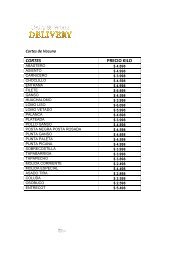CONCENTRATING SOLUTIONS FOR A PLANAR ... - CAPDE
CONCENTRATING SOLUTIONS FOR A PLANAR ... - CAPDE
CONCENTRATING SOLUTIONS FOR A PLANAR ... - CAPDE
Create successful ePaper yourself
Turn your PDF publications into a flip-book with our unique Google optimized e-Paper software.
satisfies<br />
⎧<br />
⎨<br />
⎩<br />
∆v + v p = 0, in Ω ξ,δ ,<br />
v > 0, in Ω ξ,δ , v = 0, on ∂Ω ξ,δ ,<br />
7<br />
(2.1)<br />
where ξ is a given point in Ω, δ is a positive number with δ → 0, and Ω ξ,δ<br />
is the expanding domain defined by Ω−ξ<br />
δ<br />
.<br />
In this section we will show that the basic elements for the construction<br />
of an approximate solution to problem (1.1) which exhibits one point of<br />
concentration (or equivalently of problem (2.1)) are the radially symmetric<br />
solutions of the problem (1.2) given by U δ,ξ defined in (1.3).<br />
For U δ,ξ (x) defined in (1.3), we denote by P U δ,ξ (x) its projection on the<br />
space H0 1(Ω), namely P U δ,ξ(x) is the unique solution of<br />
{ ∆P Uδ,ξ = ∆U δ,ξ in Ω,<br />
P U δ,ξ (x) = 0 on ∂Ω.<br />
Since P U δ,ξ (x)−U δ,ξ (x)+log(8δ 2 )+4 log<br />
1<br />
|x−ξ| = O(δ2 ) uniformly on x ∈ ∂Ω<br />
as δ → 0 (together with any boundary derivatives), by harmonicity we get<br />
P U δ,ξ (x) = U δ,ξ (x) − log(8δ 2 ) + 8πH(x, ξ) + O(δ 2 ) in C 1 (¯Ω) (2.2)<br />
P U δ,ξ (x) = 8πG(x, ξ) + O(δ 2 ) in C 1 loc (¯Ω \ {ξ}),<br />
provided ξ is bounded away from ∂Ω.<br />
Assume now that<br />
δ = µe − p 1<br />
4 ,<br />
C<br />
and define<br />
u(x) = e p<br />
2(p−1)<br />
Observe that, as p → ∞,<br />
p p<br />
p−1 µ 2<br />
p−1<br />
≤ µ ≤ C, (2.3)<br />
P U δ,ξ (x) x ∈ Ω. (2.4)<br />
u(ξ) → √ e and u(x) = O( 1 ) for x ≠ ξ.<br />
p<br />
Furthermore, under the extra assumption that the parameter µ is defined<br />
by the relation<br />
log(8µ 4 ) = 8πH(ξ, ξ),<br />
a direct computation shows that a good first approximation for a solution<br />
to problem (1.1) exhibiting only one point of concentration is given by a<br />
perturbation of the function u defined in (2.4).<br />
Indeed, in the expanded variable y = x−ξ<br />
δ<br />
∈ Ω−ξ<br />
δ<br />
, if we define v(y) =<br />
δ 2<br />
p−1 u(δy + ξ), then our first approximation (2.4) looks like<br />
1<br />
p p<br />
p−1<br />
(p + U 1,0 (y) + O(e − p 4 |y| + e<br />
− p 4 )<br />
)<br />
(2.5)





